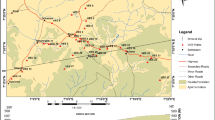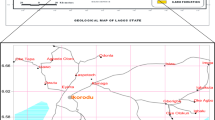Abstract
An integrated study was carried out to investigate the subsurface geological conditions in a hard rock environment, with the aim of identifying zones with groundwater resource potential. The study, in Bairasagara watershed, Karnataka, India, considered geomorphology, water level, resistivity imaging, self potential, total magnetic field and susceptibility. The signatures due to lineaments have been clearly identified and their role in groundwater movement has been documented. Synthetic simulation methods were used to model the electrical response of the lineament using finite differential modeling scheme. The inverted image of the field data is compared with the synthetic image and iteration were performed on the initial model until a best match was obtained resulting on the generation of the calibrated resistivity image of the subsurface. Resistivity imaging revealed that the dykes are weathered/fractured to a depth of 6–8 m and are compact at deeper levels, and that they behave as barriers to groundwater movement, yet facilitate a good groundwater potential zone on the upgradient side. The results of magnetic surveys were utilized in differentiating granites and dolerite dykes with an insignificant resistivity contrast. Geomorphological expression alone cannot reveal the groundwater potential associated with a lineament. However, characterizing the nature of the feature at depth with integrated geophysical methods provides essential information for assessing that potential.
Résumé
Une étude a été réalisée sur la géologique de sub-surface en milieu rocheux fracturé, avec pour objectif l’identification des zones possédant des potentiels de ressource en eau souterraine. Cette étude, sur le bassin versant de Bairasagara, Karnataka, prend en compte la géomorphologie, le niveau de l’eau, les images de résistivité, le self potentiel, le champ magnétique total et la susceptibilité. Les signaux dus à la présence de linéaments, ont été clairement identifiés ainsi que leur influence sur le mouvement des eaux souterraines. Les méthodes de simulation synthétique ont été utilisées pour modéliser la réponse électrique des linéaments, en utilisant une modélisation par différences finies. L’image inversée des données de terrain est comparée avec l’image synthétique; des itérations sur le modèle initial ont été mises en œuvre jusqu’à un rapprochement optimal, résultant en la génération d’une image calibrée de la résistivité de la sub-surface. Les images de résistivités révèlent que les dykes sont altérés et fracturés sur une profondeur de 6 à 8 mètres et sont compactés à des profondeurs plus importantes. Les dykes se conduisent dés lors comme des barrières au mouvement des eaux souterraines. Cependant ils favorisent un bon potentiel, du point de vue de la remontée des gradients. Les résultats des levés magnétiques ont été utilisés pour différencier les dykes de granite et les dykes de dolérite avec des contrastes de résistivité trop faibles. L’étude géomorphologique seule n’aurait pu suffire à comprendre le potentiel des eaux souterraines associé aux linéaments. Par ailleurs, la caractérisation des formes en profondeur avec des méthodes de géophysique intégrée, apporte des informations essentielles pour réaliser un bilan des potentiels.
Resumen
Un estudio integrado se llevó a cabo para investigar las condiciones geológicas del subsuelo en un ambiente de rocas duras, con el objetivo de identificar las zonas con potencial de recurso de agua subterránea. El estudio, en la cuenca de Bairasagara, Karnataka, incluyó geomorfología, nivel de agua, proyección de imágenes de resistividad, auto potencial, campo magnético total y susceptibilidad magnética. Los rasgos característicos debidos a los lineamientos se han identificado claramente y su papel en el movimiento del agua subterránea se ha documentado. Se usaron los métodos de simulación sintéticos para modelar la respuesta eléctrica del lineamiento, mediante el uso de un esquema de modelación de diferencias finitas. La imagen invertida de los datos del campo se comparó con la imagen sintética y se realizó iteración en el modelo inicial hasta que se logró la mejor coincidencia, que resultó en la generación de la imagen de la resistividad calibrada del subsuelo. Las proyecciones de imágenes de resistividad, revelaron que los diques están meteorizados y fracturados hasta una profundidad de 6–8 m y son compactos a niveles más profundos, y que ellos se comportan como barreras al movimiento del agua subterránea, aunque contribuyen a formar una zona con buen potencial en el sector de aguas arriba. Se utilizaron los resultados de los estudios magnéticos para diferenciar granitos y diques de dolerita que poseen un contraste de resistividad insignificante. La expresión geomorfológica por si sola no puede revelar el potencial del agua subterránea asociada con un lineamento. Sin embargo, al caracterizar la naturaleza del rasgo en profundidad con los métodos geofísicos integrados, se obtiene la información esencial para evaluar ese potencial.







Similar content being viewed by others
References
Ahmed MV (1964) A laboratory study of streaming potentials. Geophys Prospect 1(1):49–64
Atchuta Rao D, Ram Babu HV Sanker Narayan PV (1981) Interpretation of magnetic anomalies due to dikes: The complex gradient method. Geophysics 46:1572–1578
Baker SS, Cull JP (2004) Streaming potential and groundwater contamination. Explorat Geophys 57(1):41–44
Barker R, Rao TV, Thangarajan M (2001) Delineation of contaminant zone through electrical imaging technique. Curr Sci 81(3):277–283
Barker RD (1978) The offset system of electrical resistivity sounding and its use with a multi-core cable. Geophys Prospect 29:128–143
Barker RD (1992) A simple algorithm for electrical imaging of the subsurface. First Break 10:53–62
Chand R, Chandra S, Rao VA, Singh VS, Jain SC (2004) Estimation of Natural Recharge and its Dependency on Subsurface Geoelectric Parameters. J Hydrol 299:67–83
Edet AE, Okereke CS, Teme SC, Esu EO (1998) Application of remote sensing data to groundwater exploration: A case study of the Cross River State, southern Nigeria. Hydrogeol J 6(3):394–404
Fagerlund F, Heinson G. (2003) Detecting subsurface groundwater flow in fractured rock using self potential methods. Environment Hydrol 285:114–124
Fitterman DV (1979) Calculation of self potential anomalies near vertical contacts. Geophysics 41(2):195–205
Griffiths DH, Barker RD (1993) Two-dimensional resistivity imaging and modeling in areas of complex geology. J Appl Geophys 29:211–226
Griffiths DH, Turnbull J (1985) A multi-electrode array for resistivity surveying. First Break 3(7):16–20
Griffiths DH, Turnbull J, Olayinka AI (1990) Two-dimensional resistivity mapping with a computer- controlled array. First Break 8:121–129
Gustafsson P (1994) SPOT satellite data for exploration of fractured aquifer in semi-arid area in southern Bostwana. Appl Hydrogeol 2(2):9–19
Haricharan P, Ramlinga Reddy K, Murthy BVS (1984) An example of determining parameters of a dolerite dyke through resistivity survey. Geoviews xi(1):35–42
Koefoed O (1979) Geosounding Principles 1: Resistivity sounding measurements. Elsevier Science Publishing Co., Amsterdam
Krishnamurthy NS, Rao VA, Negi BC, Kumar D, Jain SC, Ahmed S, Dhar RL (2001) Electrical, self potential and mise-à-la-masse investigations in Maheshwaram watershed, Andhra Pradesh, India. Tech. Rep. no. NGRI-2001-GW-314
Krishnamurthy NS, Rao VA, Negi BC, Kumar D, Jain SC (2003a) Geophysical Exploration for Identification of old workings in East Basuria, NGRI Technical Report No. NGRI-2003-GW-389
Krishnamurthy NS, Kumar D, Marc D, Henri R (2003b) Integrated geophysical investigations. Vol. 1 of scientific report of IFCPAR project no. 2013-1, 2003, pp. 65
Lattman LH, Parizek RR (1964) Relationship between fracture traces and the occurrence of groundwater in carbonate rocks. J Hydrol 2:73–91
Loke MH (2001) Rapid 2D resistivity forward modeling using the finite difference and finite element methods. RES2DMOD version 3.0 manual, pp 11
Loke MH, Barker RD (1996) Rapid least-squares inversion of apparent resistivity pseudo sections using a quasi-Newton method. Geophys Prospect 44:131–152
Mabee BS, Curry PJ, Hardcastle KC (2002) Correlation of Lineaments to ground water inflows in bedrock tunnel. Ground Water 40(1):37–43
Mabee SB, Hardcastle KC, Wise DU (1994) A method of collecting and analyzing lineaments for regional scale fractured-bedrock aquifer studies. Ground Water 32(4):884–894
Magowe M, Carr JR (1999) Relationship between lineaments and ground water occurrence in western Bostwana. Ground Water 37(2):282–286
Mahmood A (1996) Lineaments as groundwater exploration guides in hard rock terrain of arid regions. Can J Remote Sens 22(1):108–116
Mukerjee PK (1986) A textbook of geology, The World Press Private Limited, pp. 543
Parkhomenko EI (1971) Electrification phenomena in rocks, New York, NY, 285
Sander P (1997) Water well siting in hard rock areas: identifying promising targets using a probabilistic approach. Hydrogeol J 5(3):32–43
Sander P, Minor TM, Chesley MM (1997) Groundwater Exploration based on lineament analysis and reproductivity tests. Ground Water 35(5):888–894
Siddiqui SH, Parizek RR (1971) Hydrogeology factors influencing well yields in folded and faulted carbonate rocks in central Pennsylvania. Water Resour Res 7(5):1295–1312
Wanfang Z, Beck FB, Stephenson JB (1999) Investigation of groundwater flow in karst areas using component separation of natural potential measurement. Environ Geol 37(1–2):19–25
Yin ZY, Brook GA (1992) The topographic approach to locating high yield wells in crystalline rocks: Does it work? Ground Water 30(1):96–101
Acknowledgment
We are thankful to Dr. V. P Dimri, Director, NGRI, Hyderabad for according permission to publish this paper. We thank to Dr. R. L. Dhar and Sri. S. C. Jain for their valuable discussion and suggestions. The Department of Science and Technology (Government of India) has financed the investigations. Authors are also grateful to reviewers (Sue Duncan, Dr. Perry Olcott, Dr. Allen Rodhe and Dr. Mehrdad Bastani) for their critical review and valuable suggestions.
Author information
Authors and Affiliations
Corresponding author
Additional information
An erratum to this article can be found at http://dx.doi.org/10.1007/s10040-006-0097-1
Rights and permissions
About this article
Cite this article
Chandra, S., Rao, V.A., Krishnamurthy, N.S. et al. Integrated studies for characterization of lineaments used to locate groundwater potential zones in a hard rock region of Karnataka, India. Hydrogeol J 14, 767–776 (2006). https://doi.org/10.1007/s10040-005-0480-3
Received:
Accepted:
Published:
Issue Date:
DOI: https://doi.org/10.1007/s10040-005-0480-3




